
Guangzhou (Canton) is the capital of Guangdong province and the 3rd. largest metropolis in China. The city is more than 2,000 years old. Since its beginnings, the city has been known as a trading zone, standing out for being the main port of maritime Silk Road.
Important historical events took place in Guangzhou, such as the Opium Wars (19th century) and the founding of the Chinese Republic (early 20th century).
Like any big city, it has a lot to offer to its visitors. Despite being worldwide known as Canton Fair’s headquarters, the largest trade fair in China, Guangzhou also has cultural, historical, and natural tourist attractions.
In this article, we present to you 7 must-see places in Guangzhou. Check it out!
1. Yuntai Garden

Yuntai Garden is the pearl of Guangzhou. It is a 120,000 m2 flower park, located at the southern entrance to Baiyun Mountain Complex. Opened in 1995, the place is huge, making it very difficult to enjoy everything the park has to offer.
There are more than 200 different types of flowers to appreciate. But, it’s not just flowers! The park has also beautiful lakes, gardens, sculptures, Roman columns, and even Dutch windmills and houses.

On the day we visited it, exhibitions and arrangements for the Chinese New Year’s Celebration were being prepared. Right at the entrance, there was a beautiful staircase with many designs and colors, which, unfortunately, was closed for visitors at that moment.
Yuntai Garden is a place to stay in contact with nature, a place for relaxation and contemplation in Guangzhou. It is great for walks and for photography sessions. Tourists usually visit Yuntai Garden along with Baiyun Mountain.
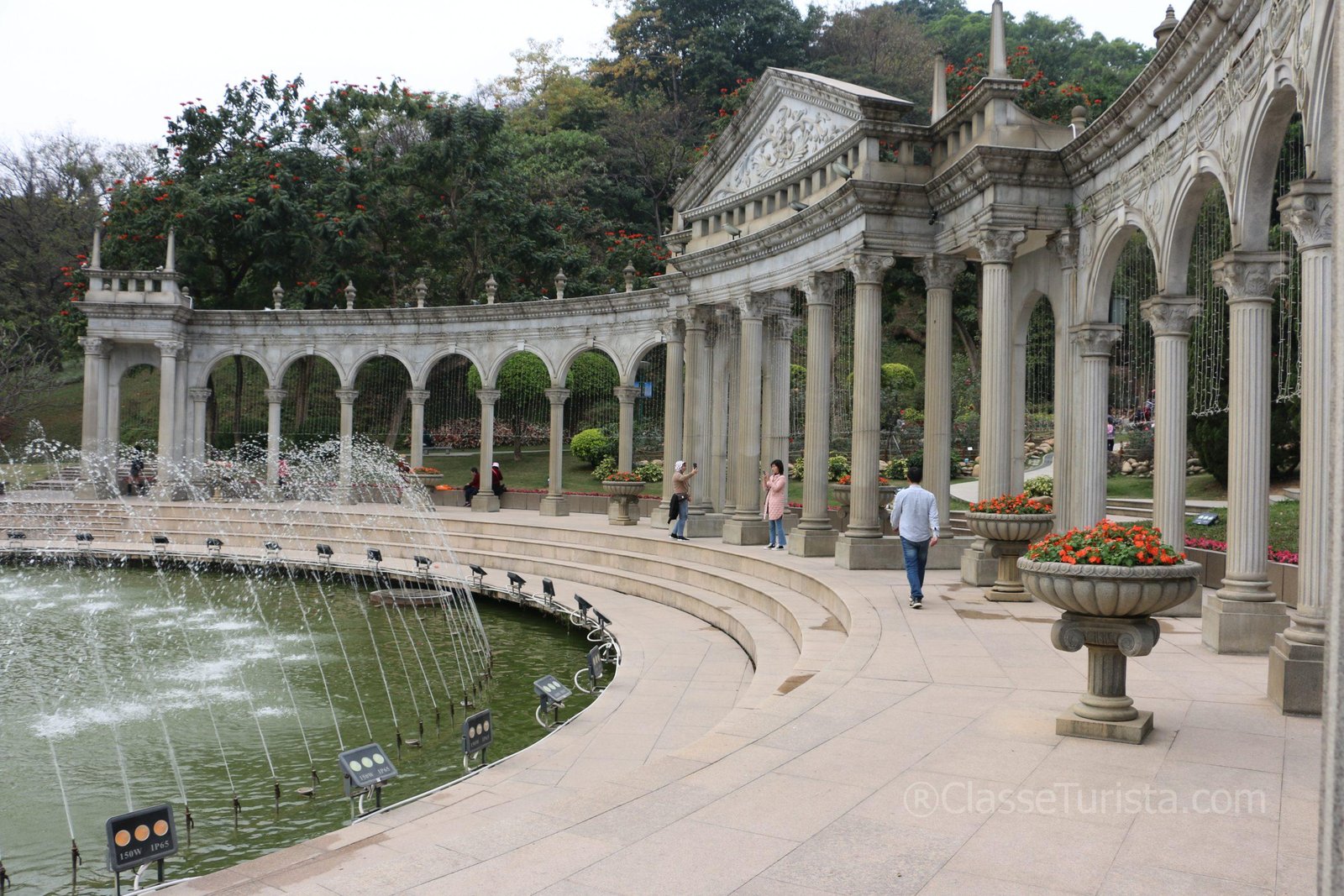
At Yuntai Garden, the following areas stand out:
- Roman Collonade: beautiful Roman columns on the banks of a lake. In front of these columns, one can find some water sprinklers.
- Rose Garden: a 1,500-square-meter garden with more than 100 species of roses in different sizes and shapes.
- Glass Green House: a 1,200 m2 glass greenhouse used especially for cultivating orchids and cactuses.
- Ecological Valley: a 130,000-square-meter natural valley. It’s a new area with mountains, forests, a lake, fishes, birds, and pavilions that create an ecological environment. Unfortunately, the ecological valley was closed at the time we visited it.
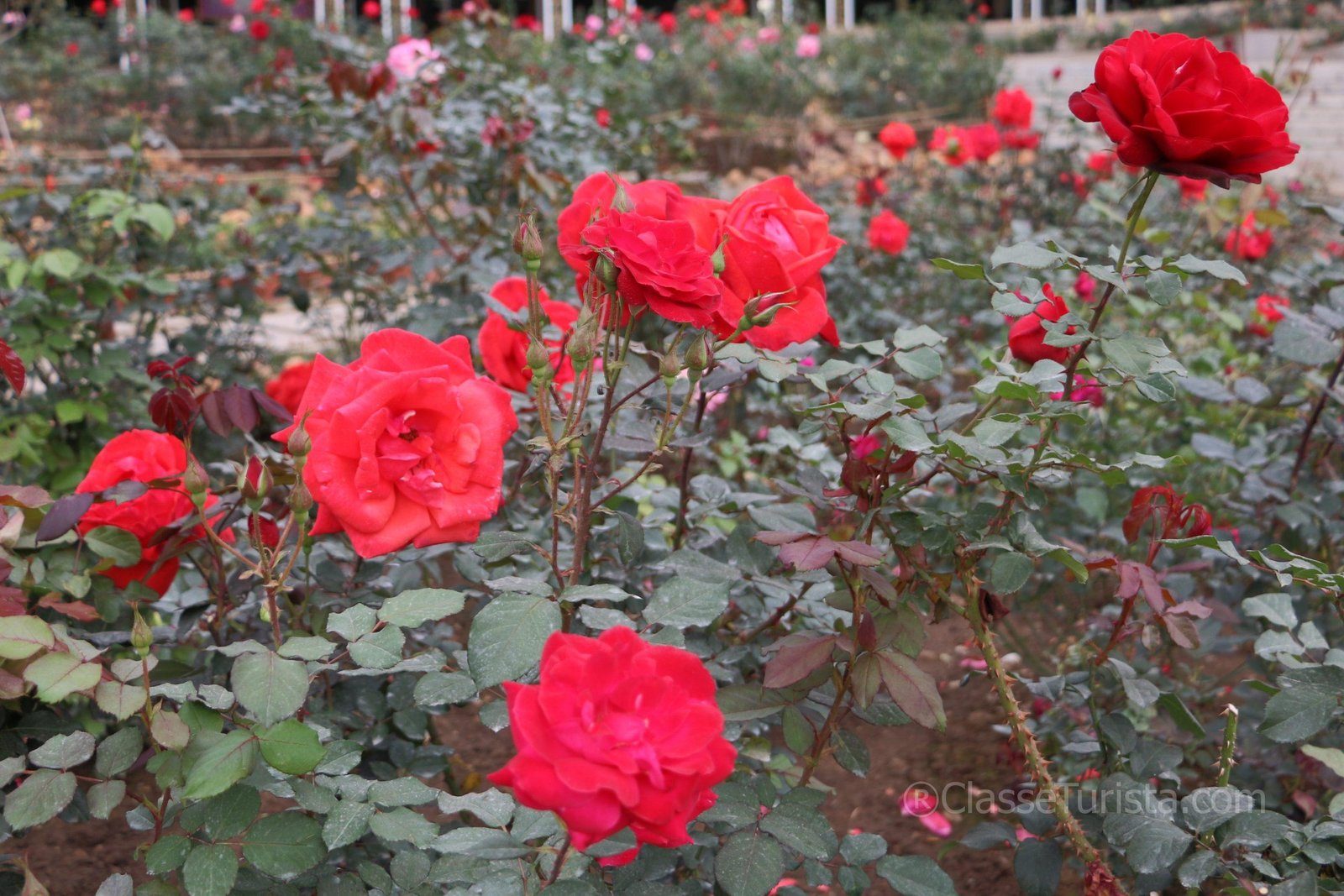
The ticket costs 10 yuans and the garden is open from 8 am to 5 pm. The best time to visit Yuntai Garden is in the spring or summer when flowers are glowing.

Unfortunately, there is no metro station nearby. It’s possible to take buses n. 223, 218, 199, 179, and 175. In our case, we stayed for a long time at a bus stop and the bus didn’t arrive. So we decided to call a car with the Didi Greater China app.
2. Baiyun Mountain

Baiyun Mountain (Baiyunshan – 白云 山), also called White Cloud Mountain, has been a point of interest since the most remote times (200 BC). The mountain is believed to be the protector of the city of Guangzhou. The name Baiyun (白云) means “White Cloud” in Mandarin. Shan (山) means mountain. The origin of this name is due to the formation of a crown of clouds around the mountain, especially after the rain.
Located at more than 1,300 ft. of altitude, the mountain is a huge space with several peaks. “Moxing Summit” is the highest peak of all. The mountain is surrounded by forest, that’s why it is also called the “City’s Lungs”.

The place is ideal for those who want to escape the hustle and bustle of the city and want to be in contact with nature. There are several attractions in the mountain that include cultural sites, temples, restaurants, viewpoints, tea houses, and, also, kid’s attractions.
- Hint: in some references made to Baiyun Mountain, people also include the attractions in its lowest part, such as Yuntai Garden and Luhu Park.
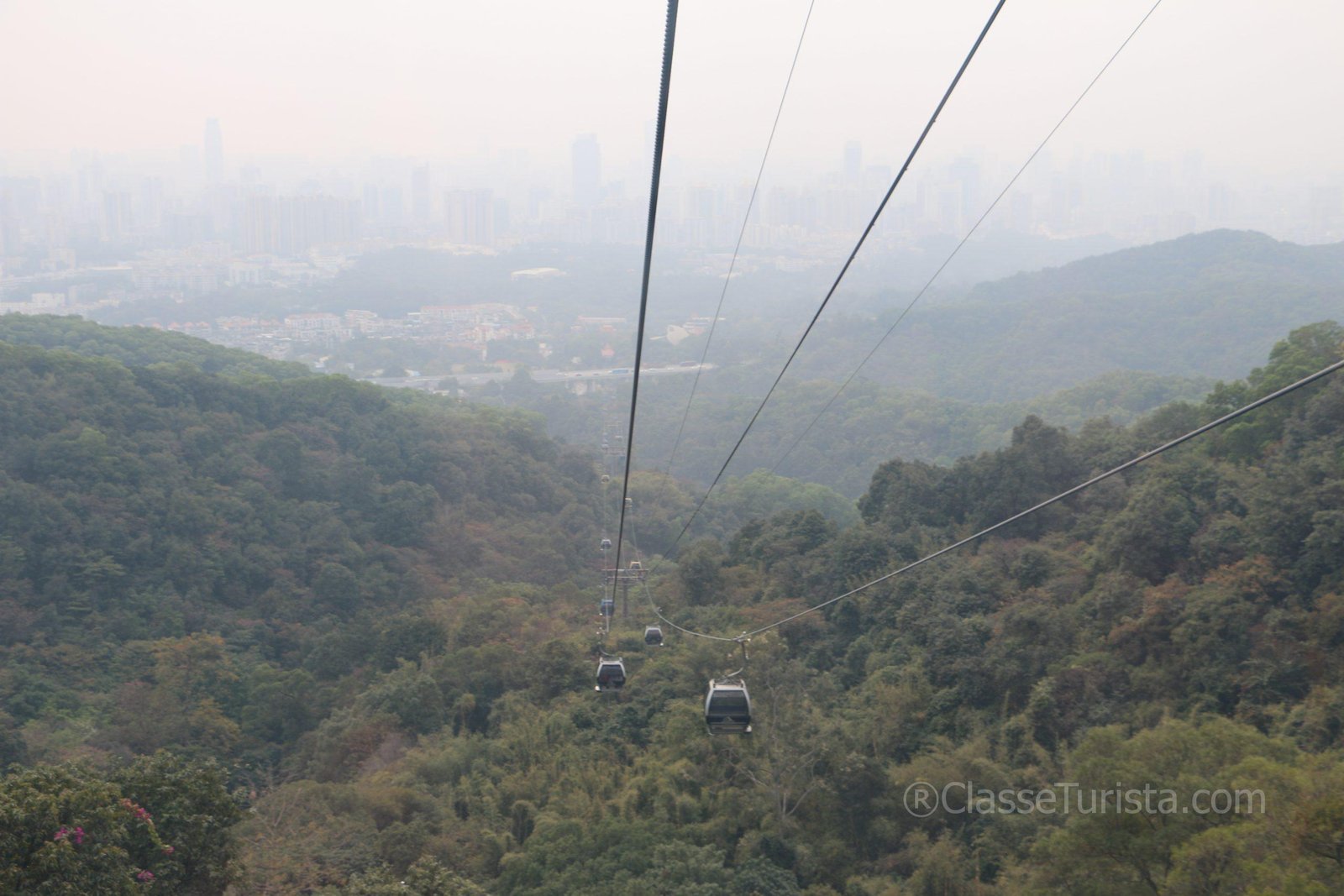
To get there, the best way is to take the cable car, whose entrance is next to Yuntai Garden. The ticket costs 25 yuan to go up and 20 yuan to go down. The cable car takes you to the Mountain top Square where you can find viewpoints, cafes, and snack bars.
But, as I said, the mountain area is huge.
Get ready to walk uphill to discover the other parts of the mountain. What I recommend you is to take one of those electric cars that operate on pre-defined routes.
Guangzhou Steles
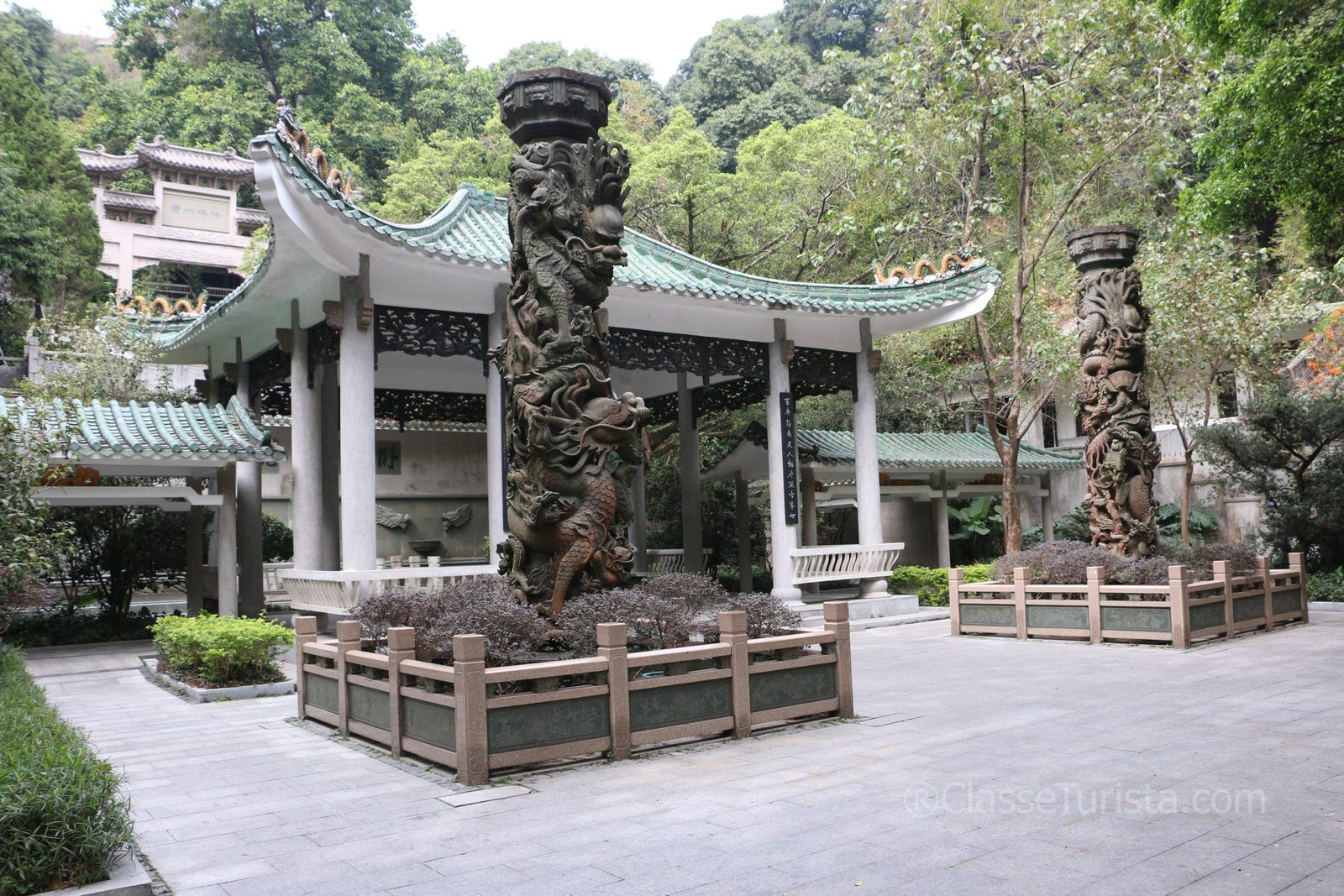
I walked along a route called Jiulongquan to a place known as “Guangzhou Steles” or “Guangzhou Forest of Stone Tablets” (Jiulongquan is, by the way, the fastest way to reach the “Moxing Summit”, but be prepared to walk).
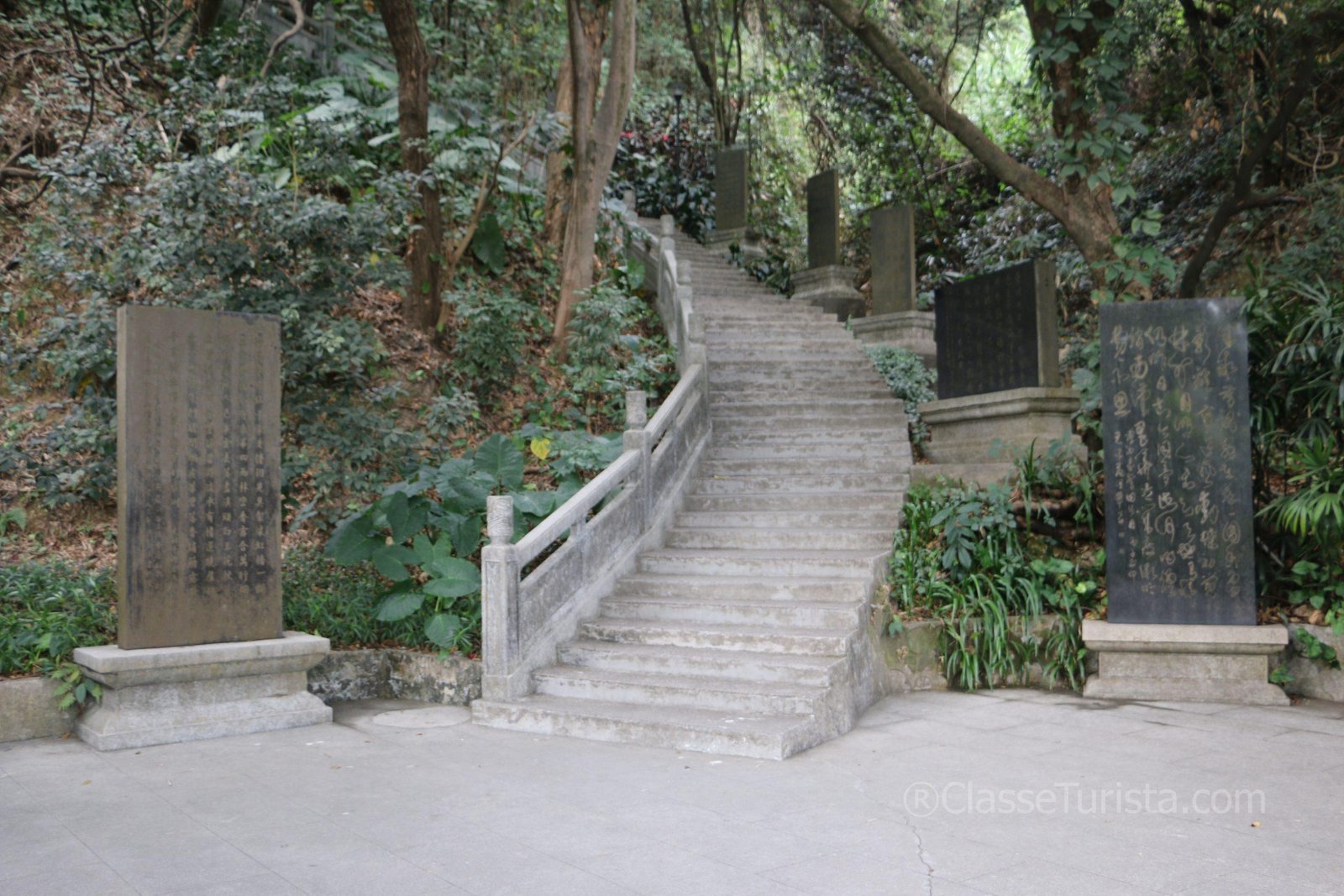
After going through a portal and a building, you can climb several stairs, passing some of these stone boards with Chinese poets and calligraphers works. There are viewpoints on several levels, but the views are not so good.
There are so many attractions in the Baiyun mountain region, that I think it is worth staying a full day just there. One can visit the following attractions in the high and low parts of the mountain: Luhu Park, Yuntai Garden, Moxing Summit, Sculpture Park, Yunxi Ecological Park, Baiyun Songtao, among others.
3. Shamian Island
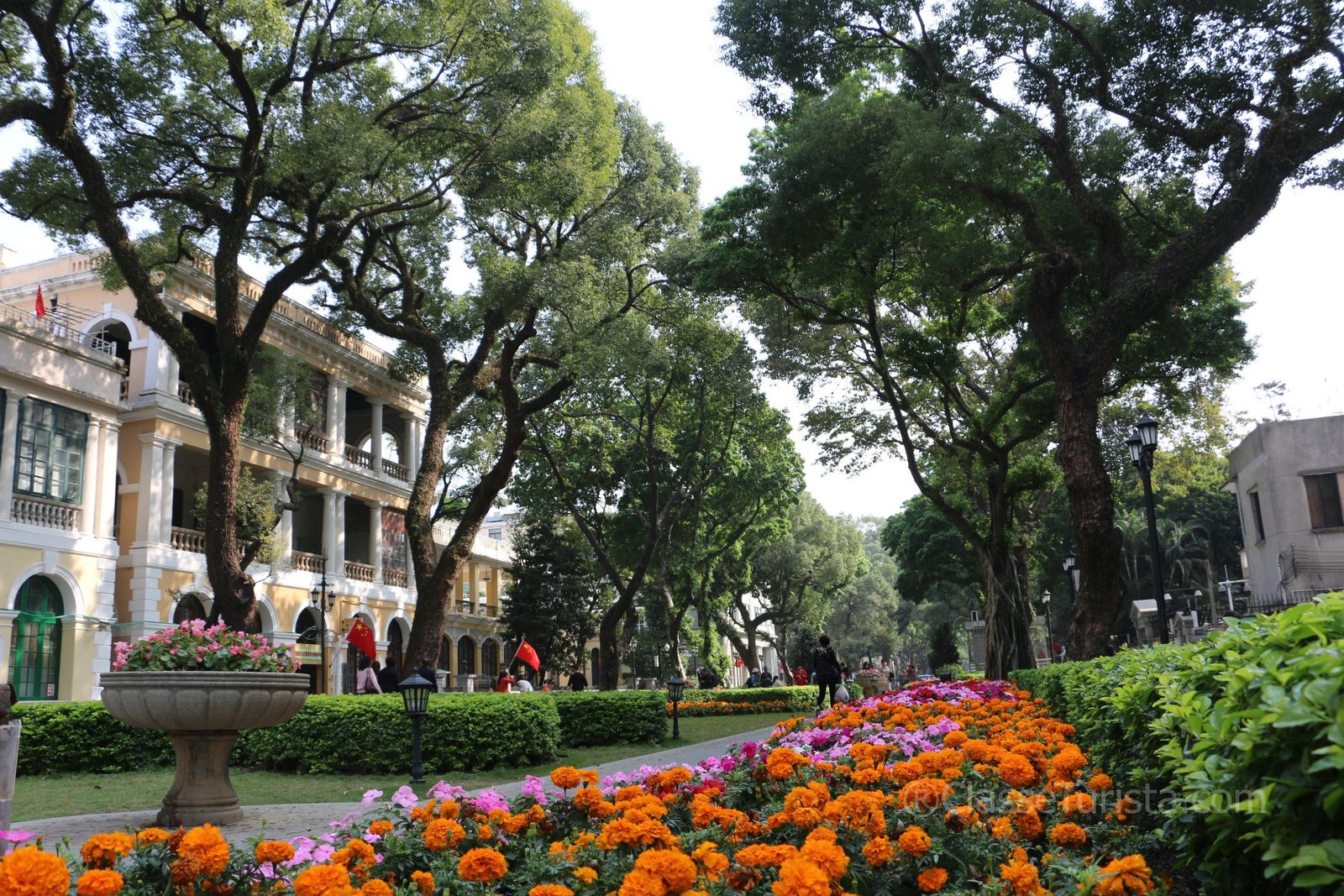
Shamian means “sandy surface” in Chinese. It is not an island, but a sandbar in the Pearl River. It became a strategic place of defense during the Opium Wars, but its fortifications were taken by the British.
After the Opium Wars, Shamian was granted to Britain and France (1859-1943). Britain got 4/5 of the area, in the west, and France got 1/5, in the east.
During the concession, the foreign powers dug an artificial river, turning Shamian an island. Boardwalks and several European-style buildings were built, including churches and foreign diplomatic representations. Companies from several countries have settled in mansions by the waterfront. Two bridges connected Shamian with the mainland: the Bridge of England and the French bridge. In the end, the island acquired its current configuration due to European colonization.
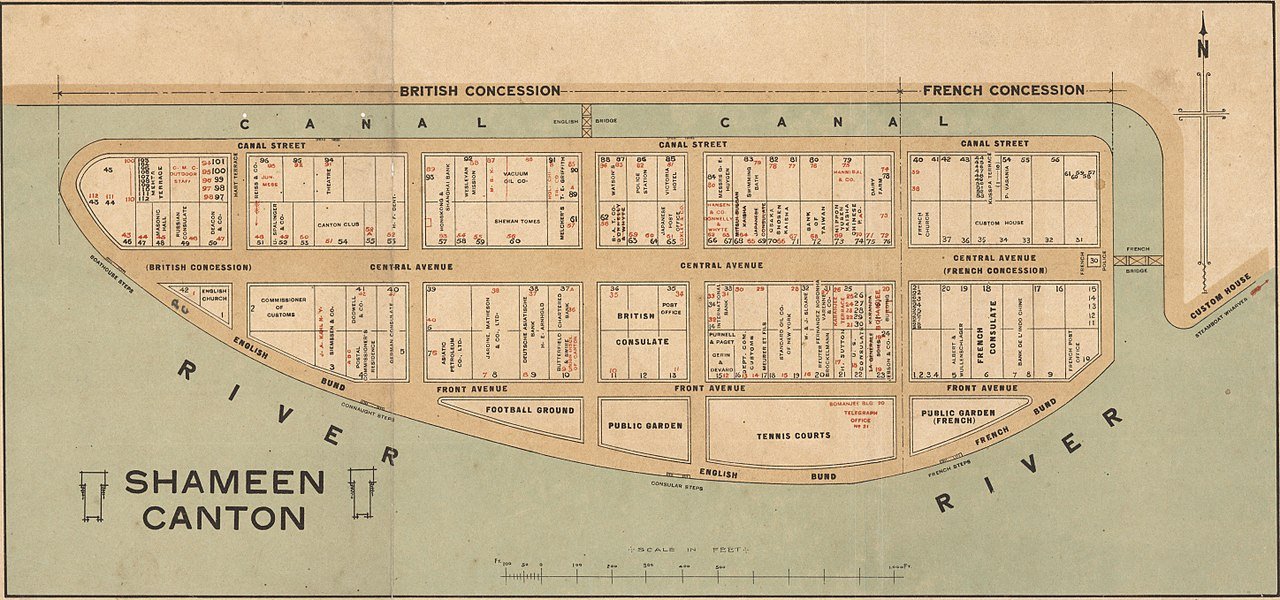
Currently, the elliptical-shaped island (3,000 ft x 1,000 ft) is an excellent place to escape the bustle of the metropolis, take a walk, or simply go back in time. There are practically no cars driving on the island. Nowadays, you can find hotels, restaurants, and cafes there. Central avenue stands out. It’s a wide boulevard with beautiful gardens and fountains. Everything well maintained!

Bronze statues are scattered throughout the island, depicting the way of life in the colonial era. Many visitors stop to take pictures. Not just that!
At the waterfront, we were delighted with a Chinese group dancing and having fun on the banks of the Pearl River.
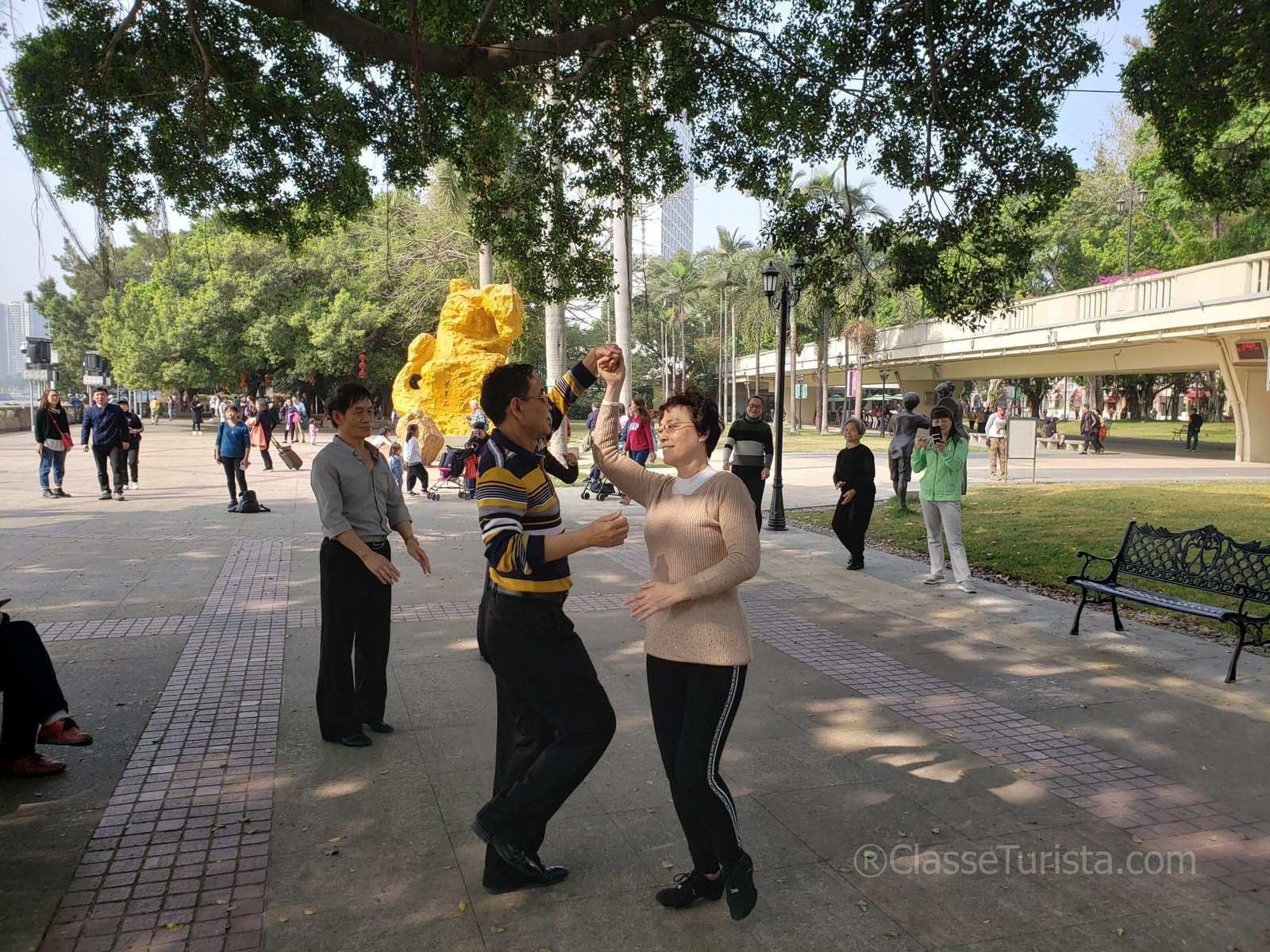
To get to Shamian Island, you can get off at Huangsha subway station (lines 1 or 6) and take exit F. Then, cross a footbridge over the canal to reach the Island.
4. Sun Yat-Sen Memorial Hall
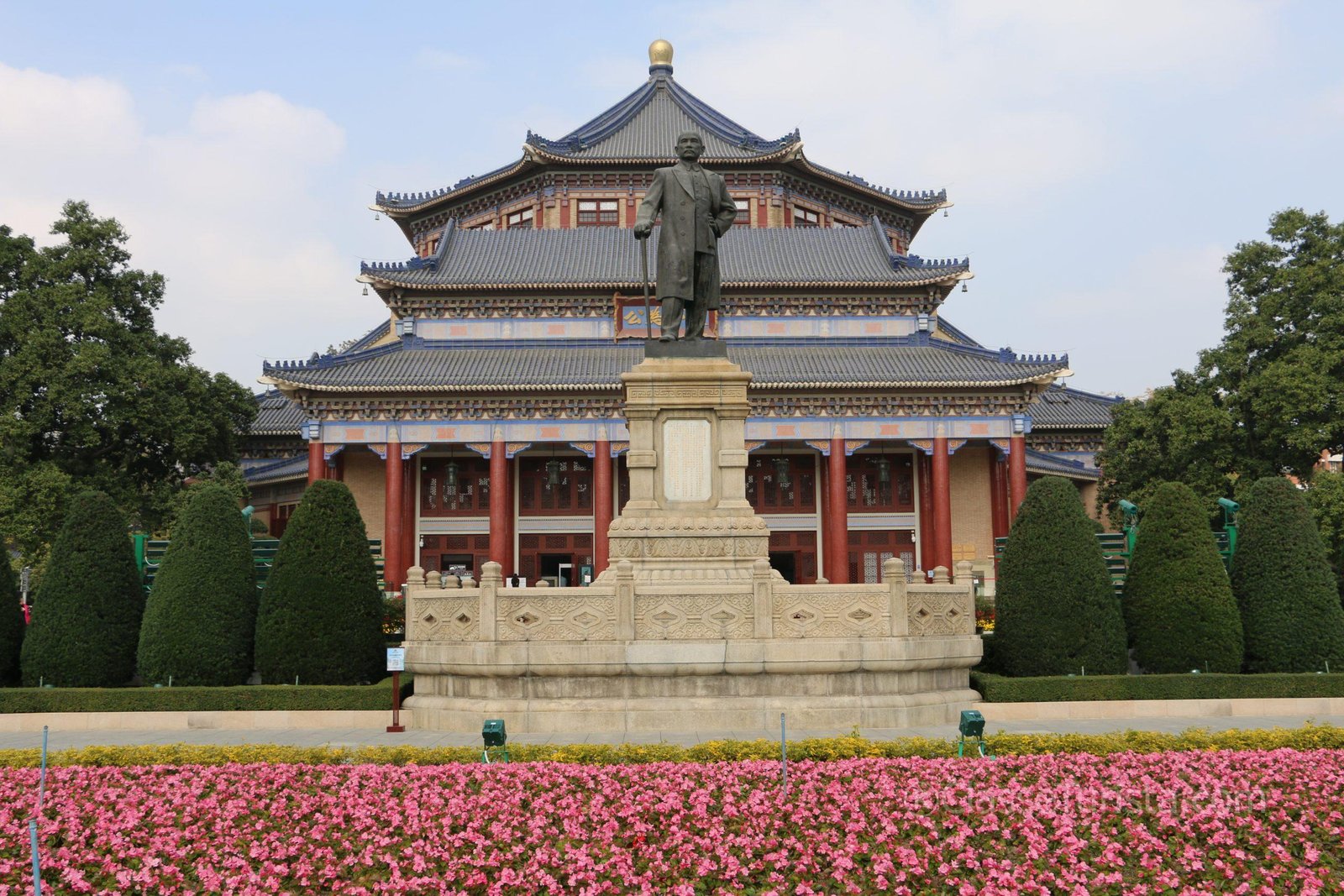
Sun Yat-Sen (1866-1925) was a Chinese doctor, philosopher, and politician. Considered the Father of the Chinese Republic, he is one of the few political leaders revered both in Taiwan and in Mainland China. By the way, Sun Yat-Sen was also known as Zhongshan.
He was in exile several times and participated in several uprisings against the Qing dynasty. Guangzhou was used as a base for one of these uprisings. With the Xinhai revolution, which culminated in the emperor’s abdication, he was chosen as the first provisional President of the Republic of China. However, the country was politically fragmented. The unification only took place under the leadership of Chiang Kai-Shek in 1927. Unfortunately, he did not survive to see his country unified.

Sun Yat-Sen received honors in China and abroad. Its mausoleum, for example, is in Nanjing, China’s former capital. The city of Zhongshan, also in Guangdong province, was named after him. Likewise, in several Chinese cities, there is Zhongshan Street (Zhongshan Lu). As I told you before, Sun Yat-Sen was also called Sun Zhongshan.
In Guangzhou, you will find the Sun Yat-Sen Memorial Hall, built in the former Government Headquarters (1912-1925). The construction took place from 1929 to 1931. The memorial has 62,000 m2. The outdoor area is very beautiful and has well-kept gardens.

The main building is an octagonal-shaped construction with 6,600 square meters. In front of the building, an 18-foot bronze statue of Sun Yat-Sen stands out, so as the 8 red pillars that support the structure.
Just above the facade, 4 Chinese characters convey a message written by Sun Yat-Sen himself. “Tian Xia Wei Gong” means “the world belongs to everyone”, in contrast to the imperial dynasty’s view, whose motto was “All under heaven”.
In the main building, there are 2 floors accessible to visitors with panels that tell the story of Sun Yat-Sen and the construction of the memorial. In the center, a beautiful auditorium holds up to 3,240 people. An octagonal dome also draws attention to anyone there. When we visited, in January 2020, we were able to observe some rehearsals for the Chinese New Year festivities.

Admission is 10 yuan for the exhibition inside the building. In the external areas, the visitor can walk for free.
To get to the Memorial, just get off at the Sun Yat-Sen Memorial Hall subway station and take exit D.
5. Zhujiang New Town
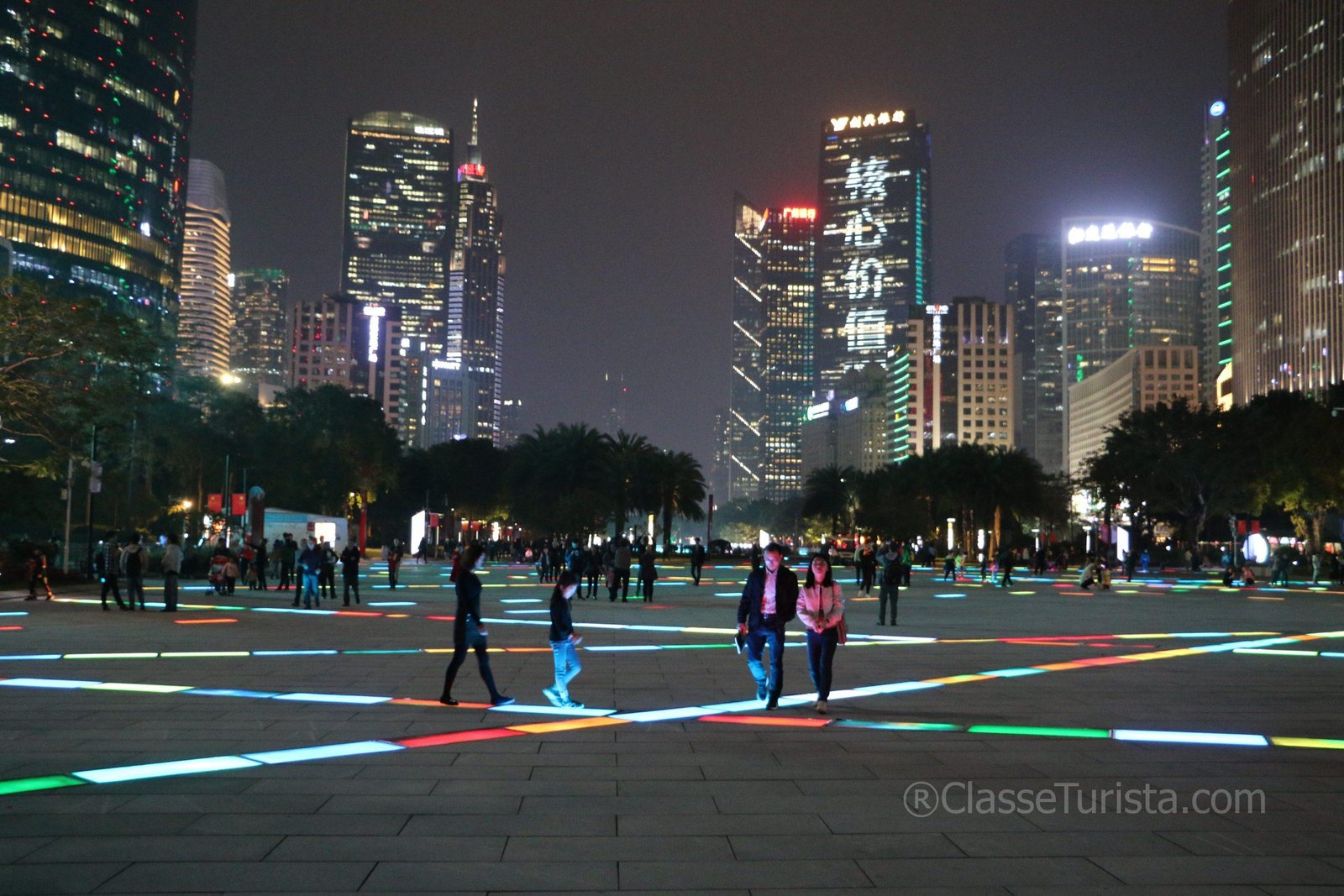
Zhujiang New Town is Guangzhou’s new CBD, but it also contains a residential area. It is an area of 6.44 km2 that has been redeveloped, especially for the Asian Games of 2010. It is currently home to the largest concentration of luxury hotels and commercial offices in Guangzhou. Consulates of the United States and Australia have also settled there.

In the central area, there is a 1.5 km long “open plaza”. In fact, there are 5 open squares linked from north to south until the Haixinsha Island. The “open plaza” includes underground shopping centers and it is surrounded by modern and imposing buildings.
Among these buildings, the Guangzhou Library stands out. It is huge, with 9 floors, all equipped with computers. It was amazing to see how many people were studying there.

Other very important buildings in Zhujiang New Town are the Guangdong Museum, the Guangzhou Opera, the IFC Tower, and the Pearl River Tower.
Southwards, you can see, on the other side of the Pearl River, the also imposing and famous Canton Tower.
There are two options for getting to Zhujiang New Town: by subway, alighting at Zhujiang New Town station (line 3), and by people mover, a special line of autonomous trains that operate there.
6. Canton Tower

Canton Tower is a 600-meter tower located in Haizhu district, on the banks of the Pearl River. It is the Guangzhou postcard. It is the second-largest TV tower in China and the 4th largest in the world. The tower contains 112 floors. It was also built for the 2010 Asian Games.
The tower has a hyperboloid shape and the design was made by Dutch architect Mark Hemel, inspired by the hips of a woman who turns to look back.
At night, the tower is all lit up and sometimes carries messages.
Inside the Tower, there are restaurants, entertainment, and viewing platforms.

Two attractions in the Canton Tower stand out: the Bubble Tram and the Sky Drop. The Bubble Tram is a set of crystal cabins that walk along a track, revolving around the top of the tower. Sky Drop, in turn, is a free fall of 30 meters.
The tower ticket admission costs 150 yuan. The price of Sky Drop and Bubble Tram is 180 yuan each. To get there, I recommend taking the subway and getting off at Canton Tower East Station (line 3).
7. Beijing Lu (Beijing Road)
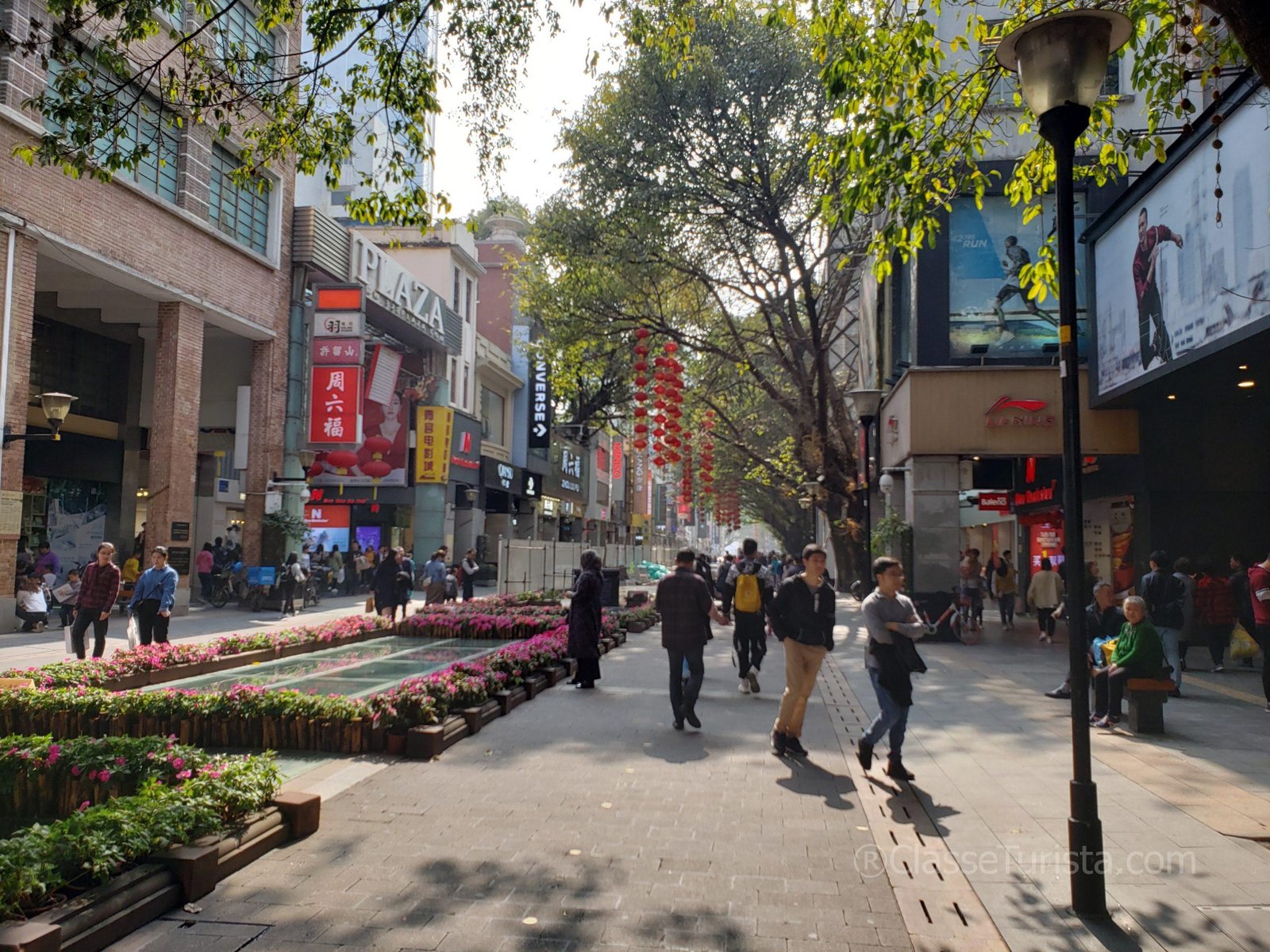
“Beijing Lu” (or Beijing Street) is a shopping street located in Guangzhou’s Yiexiu district. For the most part, it is a pedestrian street. On a normal day, 400,000 people visit Beijing Lu.
People also call “Beijing Lu” the entire shopping area around the street. There, you will find a wide variety of shopping malls, street stores, restaurants, and street vendors. Besides shopping, tourists often visit the Buddhist temples in the area.
There are many counterfeit products in the area, but there you will also find genuine products and souvenir shops. In the simplest stalls and stores, it is important to bargain. Negotiate for 1/3 of the price they first offered you.
Among the malls, the Metro Mall stands out, where you can buy cheap clothes on the 1st floor. However, you should be aware that the sizes are not perfectly suited to the western biotype. There are also several department stores in the region, such as GrandBuy, Xindaxin, Mayflower, Daxian, and Ginza. A street shop I recommend there is Miniso, where you can find good and cheap home products.
- Something that bothers the visitor is the approach of some street vendors. They want to sell watches, cleaning sprays, and other trinkets. Be assertive: say no! And never let them bring you to their stores.
Beijing Lu has a long history. In the central area of the street, the visitor can observe archaeological excavation works, covered by glass, with remnants dating from the Ming dynasty (between 1368 and 1644).
To get to Beijing Road, take the subway and get off at Gongyuanqian station (lines 1 or 2) and take exits C or D. You can also alight at Beijing Road station (line 6) and take exit B.
Bottomline
Guangzhou is not only a business city but an important tourist destination in southern China. We recommend 7 amazing places for you to visit there. Obviously, the attractions indicated are just a sample of what the metropolis has to offer to its visitors.
In addition, you can use Guangzhou as a base to take one or more day trips to other tourist destinations in China, such as Hong Kong, Macau, Guilin, and Shenzhen. Consider including Guangzhou in your travel itinerary!
- Read all our English Posts here!

